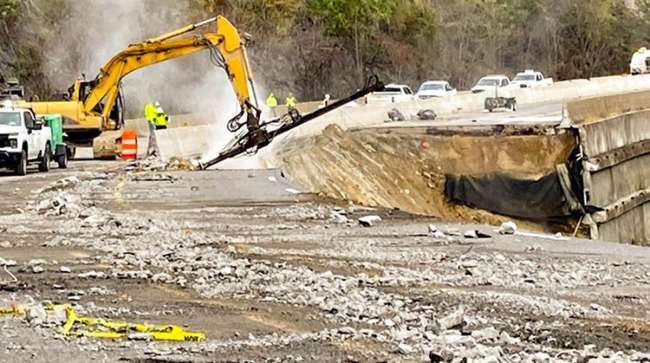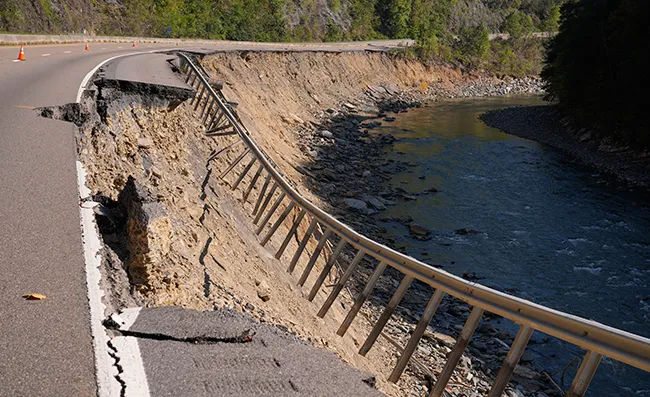I-40 Between N.C. and Tennessee Could Reopen by Jan. 1

[Stay on top of transportation news: Get TTNews in your inbox.]
Interstate 40 may reopen between North Carolina and Tennessee by New Year’s Day, though travel through the Pigeon River Gorge will be a bit slower than usual, according to the North Carolina Department of Transportation.
With more than a mile of the eastbound lanes of I-40 washed away by Hurricane Helene, traffic will be confined to a single lane in each direction on the westbound side. The lanes will be 11 feet wide, a foot narrower than the interstate standard, so the speed limit will be 40 mph.
The timing of the reopening hinges on when contractors can finish stabilizing the westbound lanes and installing a concrete barrier down the middle. The $8.5 million stabilization contract set a completion date of Jan. 4.
Steady progress is being made on Interstate 40 through the Pigeon River Gorge with 2-way traffic anticipated by New Year's Day.
📗 Read Details: https://t.co/4MUkstwpt5 pic.twitter.com/tWv83ckXlF — NCDOT (@NCDOT) November 6, 2024
NCDOT has determined that using the westbound lanes for traffic will leave enough room for contractors to rebuild the damaged and missing eastbound lanes.
“We are working to open I-40 when it is safe, and it will be tight conditions for everybody,” Wanda Payne, NCDOT’s Division 14 engineer, said in a written statement. “But if everybody is patient, everybody can get through.”
I-40 will be narrowed to one lane in each direction for 9 miles — 5 in North Carolina and 4 in Tennessee, which also lost sections of eastbound lanes. Tennessee converted its 4 miles to two-way traffic last month, though the highway was open only to the last exit in the state.
HURRICANE HELENE: North Carolina Deploys Surplus Goods to Aid Storm Recovery
It’s not clear yet how long the two-way traffic pattern will remain in place. NCDOT has identified a team of contractors to design and build the eastbound lanes, but they have not yet settled on a strategy.
“Everybody has been coming up with ideas, and all good solutions are still on the table,” Payne said. “We will collaboratively choose the best long-term solution.”

Damage from Hurricane Helene flooding along eastbound lanes of Interstate 40 near the North Carolina state line on Oct. 7 in Cocke County, Tenn. (George Walker IV via Pool/AP)
The swollen Pigeon River scoured its banks on Sept. 27 and undermined the eastbound lanes of I-40 in about 10 places in North Carolina and several more in Tennessee.
Contractors have been stabilizing the westbound lanes through a process called “soil nailing.” They drive long steel rods into bedrock below the road, fill them with grout that adheres to the rock and then spray concrete on the cliff face to hold the rods in place and create a solid wall.
Once I-40 reopens, NCDOT will have tow trucks stationed in the gorge to move cars that may break down or crash in the travel lanes.
Despite the lower speeds and potential for backups, reopening I-40 will help get people and freight through the mountains, Payne said.
“Like many things in our area, it will not be like it was for a long time,” she said. “But it will be better than we’ve had in recent weeks.”
Want more news? Listen to today's daily briefing above or go here for more info
Flooding from the remnants of Hurricane Helene severed all interstate highway access between North Carolina and Tennessee. In addition to I-40, Interstate 26 was closed at the state line after two bridges collapsed into the flooding Nolichucky River in Erwin, Tenn.
I-26 reopened Oct. 30 after the Tennessee Department of Transportation built a temporary causeway over the river while repairs to the bridge take place. Traffic is reduced to one lane in each direction where it crosses the Nolichucky, and vehicles more than 10 feet wide or overweight are prohibited and should continue to detour using interstates 81 and 77.
Distributed by Tribune Content Agency, LLC




